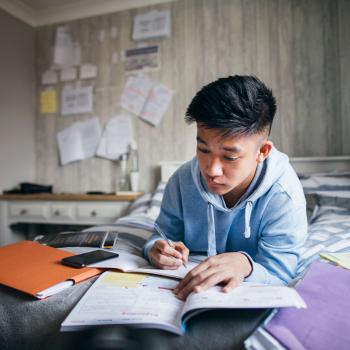Students utilize their reading and writing skills as they think critically in order to sort books in multiple ways.

Book Sorting: Using Observation and Comprehension to Categorize Books

Grades
|
Draw a Math Story: From the Concrete to the Symbolic
1 - 2
Lesson Plan
| Standard Lesson
Students create math stories by first drawing, then writing, and finally using math symbols to show addition or subtraction.

Grades
|
Book Report Alternative: Character and Author Business Cards
6 - 8
Lesson Plan
| Standard Lesson
Students respond to a book they have read by thinking symbolically to create a business card for one of the characters.

Grades
|
Book Report Alternative: The Elements of Fiction
3 - 5
Lesson Plan
| Standard Lesson
Students identify the elements of fiction in a book they have read and share summaries of them by writing and illustrating their own mini-book.

Grades
|
Book Reviews, Annotation, and Web Technology
6 - 8
Lesson Plan
| Unit
Students work in groups to create annotated book reviews with links to topics of interest related to their book.

Grades
|
Creating Class Rules: A Beginning to Creating Community
K - 2
Lesson Plan
| Standard Lesson
Students work together to create classroom rules by brainstorming why they are at school and what they need while they are there.

Grades
|
Book Report Alternative: Summary, Symbol, and Analysis in Bookmarks
6 - 8
Lesson Plan
| Standard Lesson
Students make bookmarks on computers and share their ideas with other readers at their school, while practicing summarizing, recognizing symbols, and writing reviews—all for an authentic audience.

Grades
|
Powerful Writing: Description in Creating Monster Trading Cards
3 - 5
Lesson Plan
| Standard Lesson
Students create their own monster trading cards using "powerful," vivid language to describe their creatures.

Grades
|
Choose Your Own Adventure: A Hypertext Writing Experience
6 - 8
Lesson Plan
| Unit
Students analyze "choose your own adventure" stories and brainstorm to develop setting, characters, and plots for their own adventures stories and related Websites.

Grades
|
Guess What's in the Bag: A Language-based Activity
K - 2
Lesson Plan
| Minilesson
Students play a guessing game to practice using descriptive language.

Grades
|
Technical Reading and Writing Using Board Games
3 - 5
Lesson Plan
| Standard Lesson
Students celebrate a novel they have read and get hands-on experience with technical writing by creating a board game based on the novel and writing the instructions for it.

Grades
|
Peer Review: Narrative
6 - 8
Lesson Plan
| Minilesson
This minilesson guides student in using the PQP techniquePraise–Question–Polishto offer concrete and useful peer review feedback.

Grades
|
Inside or Outside? A Minilesson on Quotation Marks and More
6 - 8
Lesson Plan
| Minilesson
Students often question whether a punctuation mark goes inside or outside the quotation marks, especially when writing dialogue. This lesson helps students identify the conventions and apply them to their text.

Grades
|
Character Clash: A Minilesson on Paragraphing and Dialogue
6 - 8
Lesson Plan
| Minilesson
Students learn about paragraphing conventions in dialogue by revising their own writing.

Grades
|
A Picture's Worth a Thousand Words: From Image to Detailed Narrative
6 - 8
Lesson Plan
| Standard Lesson
The old cliche, "A picture is worth a thousand words" is put to the test when students write their own narrative interpretations of events shown in an image.

Grades
|
Using Picture Books to Teach Setting Development in Writing Workshop
3 - 5
Lesson Plan
| Standard Lesson
Students use a graphic organizer to analyze setting development in picture books. They then apply what they have learned to their own writing.

Grades
|
Dr. Seuss's Sound Words: Playing with Phonics and Spelling
K - 2
Lesson Plan
| Standard Lesson
Boom! Br-r-ring! Cluck! Moo!Everywhere you turn, you find exciting sounds. Students use these sounds to write their own poems based on Dr. Seuss's Mr. Brown Can MOO! Can You?

Grades
|
Using Picture Books to Teach Characterization in Writing Workshop
3 - 5
Lesson Plan
| Standard Lesson
Students explore character development through experiences with picture books. They learn about the connections between reading and writing and apply the information they learn to revisions of their own writing.

Grades
|
Persuasive Writing: What Can Writing in Family Message Journals Do for Students?
K - 2
Lesson Plan
| Standard Lesson
This lesson engages children in using writing to their families as a persuasive tool to get what they want and need.

Grades
|
Letter Poems Deliver: Experimenting with Line Breaks in Poetry Writing
3 - 5
Lesson Plan
| Standard Lesson
Students explore letter poems and experiment with writing letters as poems, using the placement of line breaks to enhance rhythm, sound, meaning, and appearance.